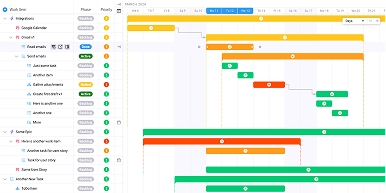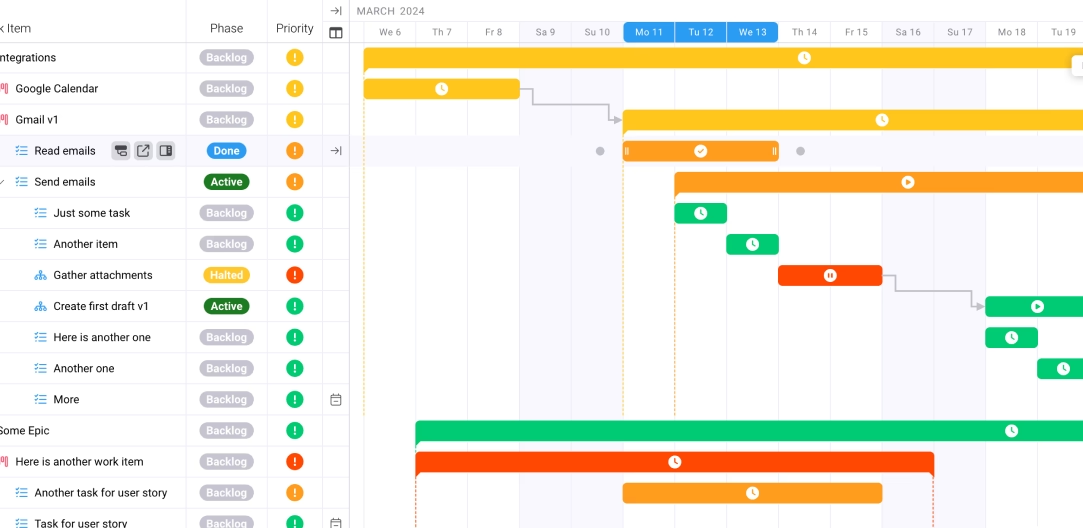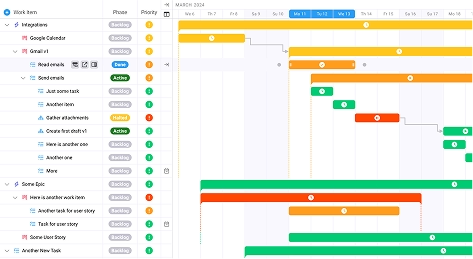
Project Management Life Cycle: A Complete Guide to the 5 Phases
Key takeaways:
- Creative teams require specialized project management approaches that balance structure with creative freedom
- Proper feedback systems and collaboration tools can reduce project delivery times by up to 50%
- Streamlined workflows help creative professionals spend more time on actual creative work rather than administrative tasks
- Technology integration and automation can significantly improve creative team productivity and client satisfaction
Creative teams today face an unprecedented challenge: balancing artistic vision with business demands while managing increasingly complex projects and client expectations. The reality is stark—70% of projects globally fail due to various factors including inadequate planning, and creative teams are not immune to this statistic. However, project management for creative teams isn’t just about preventing failure; it’s about unlocking the full potential of creative talent while delivering exceptional results on time and within budget.
The Current Challenge: Why Traditional PM Falls Short for Creatives
The creative industry operates differently from traditional business environments, yet many organizations attempt to force creative teams into rigid project management frameworks designed for manufacturing or corporate operations. This fundamental mismatch creates friction that stifles innovation and frustrates creative professionals.
Research reveals troubling statistics about the current state of creative work. 77% of creative teams say the speed at which they’re expected to work is a significant challenge, while 38% of marketing professionals identify “creating more content faster” as a major workflow hurdle. These pressures often lead to burnout, reduced quality, and ultimately, disengaged employees cost companies 18% of their salary in lost productivity.
The disconnect between creative needs and traditional project management becomes even more apparent when we examine feedback processes. 28% of creative agencies report that different client feedback preferences make it difficult to track and manage the review process. This seemingly small issue cascades into larger problems: missed deadlines, scope creep, and frustrated team members who spend more time managing chaos than creating.
Yet there’s hope. 87% of organizations give creatives the credit they deserve for their strategic business impact, indicating a growing recognition of creative teams’ value. The challenge lies in implementing project management systems that amplify this value rather than diminish it.
The Strategic Framework: Building Creative-Centric Project Management
Successful project management for creative teams requires a fundamental shift in thinking. Rather than imposing structure on creativity, the goal should be creating frameworks that support and enhance the creative process. This approach recognizes that creative work is inherently iterative, collaborative, and often unpredictable.
Foundation Principles for Creative Project Management
The first principle involves understanding the creative workflow. Unlike linear processes, creative work often follows a cyclical pattern of exploration, refinement, feedback, and iteration. Modern marketing teams require structured project management approaches to handle increasing complexity and client demands, but these approaches must be flexible enough to accommodate the creative process.
Balancing Structure with Flexibility
The most effective creative project management systems provide just enough structure to prevent chaos while maintaining sufficient flexibility for creative exploration. This balance requires careful consideration of which elements need rigid control—such as deadlines, budgets, and client requirements—and which areas should remain fluid to allow for creative iteration and discovery.
Stakeholder Alignment and Communication
Clear communication channels become crucial when managing creative projects. Unlike traditional project management where requirements are often static, creative projects involve continuous stakeholder feedback and evolving specifications. Establishing protocols for feedback collection, review cycles, and approval processes prevents the confusion that often derails creative projects.
Implementation Tactics: Five Proven Strategies for Creative Teams
Strategy 1: Implement Structured Creative Briefs and Planning
Every successful creative project begins with a comprehensive brief that captures not just what needs to be created, but why it needs to be created and how success will be measured. The brief should include target audience insights, brand guidelines, technical specifications, and clear success criteria. This upfront investment in planning prevents the costly revisions and scope creep that plague many creative projects.
Effective project management frameworks designed for marketing agencies can significantly improve creative team outcomes by establishing these clear foundations from the start.
Strategy 2: Optimize Feedback and Review Processes
The review and approval process often becomes the biggest bottleneck in creative projects. Research shows that virtual teams benefit particularly from feedback that combines performance information with team process insights. This principle applies equally to creative teams, whether working remotely or in-office.
Implementing structured feedback systems with clear guidelines for reviewers, consolidated feedback collection, and defined revision rounds can dramatically reduce project timelines. Many successful creative teams establish feedback protocols that include specific time windows for reviews, standardized feedback formats, and clear escalation procedures for conflicting input.
Strategy 3: Leverage Technology for Workflow Automation
Technology should amplify creative capabilities, not constrain them. Creative team collaboration is the secret sauce to boosting productivity and bringing out the best in everyone’s abilities. Modern project management tools designed for creative workflows can automate routine tasks, streamline file sharing, and provide real-time project visibility.
The key is selecting tools that integrate seamlessly with creative software and workflows. This might include project management platforms that integrate with design software, automated time tracking systems, and client portal solutions that streamline external communication.
Strategy 4: Establish Clear Roles and Responsibilities
Creative projects often involve multiple stakeholders with overlapping responsibilities. Establishing clear roles prevents the confusion that leads to duplicated effort or missed requirements. This includes defining who provides feedback at each stage, who has final approval authority, and who is responsible for various project components.
Streamlined campaign management processes can transform how creative teams collaborate and deliver results by clearly defining these roles and responsibilities upfront.
Strategy 5: Build in Creative Exploration Time
Paradoxically, the best project management for creative teams involves planning for the unplannable. Building buffer time for creative exploration, experimentation, and iteration prevents the pressure that leads to compromised creative work. This might involve allocating 20% additional time for initial concept development or scheduling regular “creative review” sessions where teams can present multiple directions before committing to final executions.
Measuring Success: KPIs and Metrics That Matter
Traditional project management metrics—time, budget, and scope—remain important for creative projects, but they don’t tell the complete story. Creative teams need metrics that capture both efficiency and effectiveness.
Operational Metrics
Time tracking remains crucial, but it should focus on understanding where time is spent rather than simply monitoring hours. Key metrics include time spent on actual creative work versus administrative tasks, average revision cycles per project, and time from brief to final approval.
Project velocity—measured as the number of projects completed per time period—provides insight into team capacity and workflow efficiency. However, this metric must be balanced against quality indicators to ensure speed doesn’t compromise outcomes.
Quality and Satisfaction Metrics
Client satisfaction scores and internal creative satisfaction ratings provide crucial feedback on project management effectiveness. 36.7% of content creators identify producing content consistently as their biggest challenge, highlighting the importance of systems that support sustainable creative output.
Team engagement metrics, including retention rates and internal satisfaction surveys, indicate whether project management processes support or hinder creative professionals. High turnover in creative teams often signals project management problems rather than talent issues.
Business Impact Metrics
Creative work should ultimately drive business results. Metrics might include campaign performance indicators, client retention rates, and the business value generated by creative projects. Billing efficiency and project profitability provide insight into the financial health of creative operations.
Future Considerations: Emerging Trends and Next Steps
The creative industry continues to evolve rapidly, driven by technological advancement and changing client expectations. The digital content creation market is projected to reach $63.0 billion by 2030, indicating massive growth and opportunity for creative teams that can scale effectively.
Artificial Intelligence and Automation
AI tools are increasingly supporting creative work, from automated asset generation to predictive project planning. The most successful creative teams will learn to integrate these tools while maintaining human creativity and strategic thinking. Project management systems must evolve to incorporate AI-assisted planning, automated routine tasks, and intelligent resource planning.
Remote and Hybrid Work Models
The shift toward distributed creative teams requires new approaches to collaboration and project management. Teams must develop systems for asynchronous creative work, virtual brainstorming, and remote client presentations. This trend emphasizes the importance of cloud-based tools and clear communication protocols.
Client Expectations and Market Demands
Clients increasingly expect faster turnaround times, more personalized content, and greater transparency into the creative process. Project management systems must evolve to provide real-time project visibility through client portals and automated status updates.
The future belongs to creative teams that can combine artistic excellence with operational efficiency. This requires project management approaches that respect the creative process while driving business results.
Preparing for Change
Creative leaders should invest in flexible project management systems that can adapt to changing requirements. This includes choosing tools that integrate with evolving creative software, establishing processes that can scale with team growth, and developing team capabilities that combine creative expertise with project management skills.
CRM integration becomes increasingly important as creative teams take on more strategic roles in client relationships. Understanding client history, preferences, and past project performance enables more effective project planning and execution.
The most successful creative teams will be those that embrace project management for creative teams as a competitive advantage rather than a necessary evil. By implementing thoughtful systems that support rather than constrain creativity, these teams will deliver exceptional results while maintaining the job satisfaction and creative fulfillment that attracts top talent.
Project management for creative teams represents an opportunity to unlock potential, improve client relationships, and build sustainable creative businesses that thrive in an increasingly competitive landscape. The organizations that master this balance will lead the industry into its next phase of growth and innovation.
Frequently Asked Questions
How do you balance creative freedom with project deadlines?
The key is establishing clear project phases with defined deliverables while allowing flexibility within each phase. Set firm deadlines for major milestones but provide creative teams autonomy in how they reach those milestones.
What’s the biggest mistake companies make when implementing project management for creative teams?
The most common mistake is applying rigid, linear project management frameworks designed for manufacturing or software development. Creative work requires iterative processes with built-in feedback loops and revision cycles.
How can remote creative teams maintain effective collaboration?
Remote creative teams need robust digital collaboration tools, regular check-in schedules, and clear communication protocols. Establish virtual brainstorming sessions and use collaborative design platforms that allow real-time feedback.
What project management tools work best for creative teams?
The best tools integrate with creative software, provide visual project tracking, and support collaborative feedback. Look for platforms designed specifically for creative workflows rather than generic project management software. A great option for creative teams is Ravetree.
How do you measure the ROI of creative project management?
Track metrics like project delivery times, revision cycles, client satisfaction scores, and team retention rates. Also measure business outcomes like campaign performance and client retention to demonstrate the value of effective project management.
What’s the ideal team structure for creative project management?
Successful creative teams typically include a creative lead, project manager, and clear roles for stakeholders and reviewers. The project manager should understand creative processes and serve as a bridge between creative and business requirements.
How do you handle scope creep in creative projects?
Establish clear project boundaries in the initial brief, implement a formal change request process, and educate clients about the impact of scope changes on timelines and budgets. Build some flexibility into initial estimates to accommodate minor adjustments.
What role does technology play in modern creative project management?
Technology should streamline administrative tasks, improve collaboration, and provide project visibility without interfering with the creative process. The best solutions integrate seamlessly with existing creative workflows and tools.









